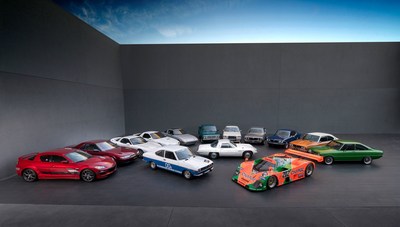News
- Mazda Looks Back at Legacy of Innovation, Starting with the 1967 Cosmo Sport 110S -
IRVINE, CA, May 30, 2017 /CNW/ - Fifty years ago today, Mazda Motor Corporation began its legacy of doing what was said couldn't be done.

Mazda — then Toyo Kogyo Corporation — needed to create a unique technology that would differentiate it among a rapidly globalizing Japanese automotive industry in order to stay independent. In 1961, Mazda licensed NSU Motorenwerke AG and Wankel GmbH's rotary engine technology, sharing learnings with the German companies in hopes of making wider use of the engine.
Once the prototype rotary engine arrived in Hiroshima, testing began. Unfortunately, within the first hour of running, the engine seized. Mazda had wagered its entire existence on this one engine technology; failure would not be an option, but early impressions meant there was much to be done to keep Mazda afloat.
Knowing how imperative the success of the rotary engine would be for the company, Chief Engineer Kenichi Yamamoto assembled a team of Mazda's most talented engineers — known as the 47 Samurai — to make the rotary engine viable. Of course, they knew other automakers from the around the world had tried or were trying to do so as well; none had succeeded, though.
After a highly lauded debut at the 1964 Tokyo Motor Show, on May 30, 1967, the Mazda Cosmo Sport 110S — the world's first production twin-rotor, rotary-engined car — went on sale in Japan. It was Mazda's first sports car, and all the more newsworthy because the company had been known only for its small passenger cars and work trucks to that point. Its low shape complemented the compact dimensions of its two-rotor engine.
Just 1,176 production Cosmo Sports would be built, but its legacy would stretch much, much further. From the earliest races, such as the 84-hour Marathon de la Route in 1968, Mazda never stopped challenging its engineers and designers to keep improving their craft.
Eventually, those efforts would spawn championship-winning motorsports programs all over the world, as well as leading the way for subsequent sports cars that focused on lightweight performance over brute strength. The highest point of Mazda's development of the rotary engine was in 1991, when the quad-rotor-powered Mazda 787B won the famed 24 Hours of Le Mans. During its production, more than 1.99 million rotary-engine vehicles were produced, from sports cars to sedans and even a 26-passenger bus.
Much as with today's Mazda cars and crossover SUVs, hashiru yorokobi — exhilaration, joy and wellbeing from driving — continues to be a critical part of what makes Mazdas what they are.
A Legacy of Innovation: Then and Now
From its earliest days as a manufacturer of high-precision machine tools to today as a provider of exceptional customer experiences through its vehicles, Mazda aims to create a strong emotional connection with customers by offering a unique combination of driving pleasure and outstanding environmental and safety performance.
Today, Mazda's SKYACTIV Technology continues to delight drivers and passengers with a human-centric focus on the entire driving experience.
But, much as was the case with the Wankel rotary engine, developing SKYACTIV Technology was thought to be an impossible task, never mind the fact that it was being developed by an independent, smaller automaker during the 2008 world financial crisis.
When Mazda introduced its SKYACTIV-Engine family, no other gasoline-powered production vehicle could operate with a 14.0:1 compression ratio — the world's highest. Similarly, no other diesel engine could achieve a 14.4:1 compression ratio either — the world's lowest. Today, Mazda's clean-operating SKYACTIV engines are still unmatched in their balance of performance, driving engagement and environmental efficiency.
Lightweight, rigid SKYACTIV-Chassis and SKYACTIV-Body units allow Mazda vehicles to thrill the driver and passengers as much as protect them. And, in combination with all other SKYACTIV Technologies, the chassis and body designs and engineering allow for an unmatched Jinba Ittai driving experience in every Mazda, whether the iconic MX-5 Miata sports car or the seven-passenger CX-9 crossover SUV — driver and car as one.
Mazda continues to push technology, engineering and design thresholds to deliver cars and crossover SUVs for people who cherish driving. Then, as now, Mazda will never stop challenging.
Mazda Canada Inc. is responsible for the sales and marketing, customer service and parts support of Mazda vehicles in Canada. Headquartered in Richmond Hill, Ontario, Mazda Canada has a nationwide network of 165 dealerships. For additional information visit Mazda Canada's media website at www.media.mazda.ca.
SOURCE Mazda Canada Inc.

